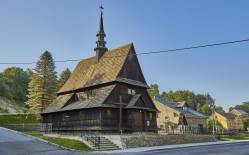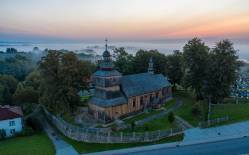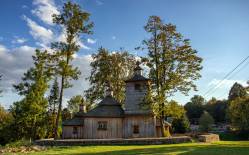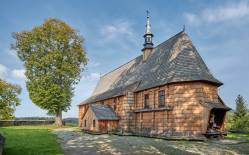The wooden church of All Saints is particularly worth visiting because of its interesting architecture.
A church existing here and first mentioned in 1487 was dismantled in the late 1760s. Only the 17th century brick sacristy, with a jewel box at the upper floor, was left intact. In 1770 a new church was built next to it.
The church, oriented towards the East, has an elongated floor plan. The nave is wider than the chancel. On the southern side there is a chapel, accessible from the nave; on the northern and western sides there are porches. The roofs, supported on king-post truss, are covered with shingles. The nave, the chapel and the chancel are covered with double-pitched roofs, the sacristy – with a three-pitched roof and the porch with a mono-pitched roof. Over the nave there is a bell turret. The church has high stone and brick foundations. The log walls are covered with shingles. The brick and stone walls of the sacristy are clad with irregular slabs of sandstone. Next to the church we can see old ash trees, a brick belfry and a morgue.
A legend has it that centuries ago, when it was decided that a new parish church should be built, people living in two villages argued whether it should be located in Wrocanka at the site of the old church or in Szczepańcowa. The village leader decided that the former had already had a church, so the latter should get it now. Wood was purchased and stored in Szczepańcowa. At night, however, the material was brought to Wrocanka and placed at the site of the old church. The case was investigated but no traces of intentional wrong-doing were found. It was then declared, and affirmed by the parish priest’s authority, that All Saints – patrons of the church, decided about its location and brought the material here. The parishioners dutifully built the church at the site chosen by All Saints.
Photo: Krystian Kłysewicz
Gallery
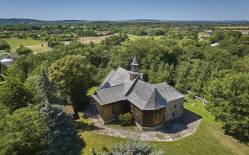
Recommended venues on the Trail



This website has been modernized with the financial support of the European Union under the Cross-Border Cooperation Programme Poland-Belarus-Ukraine 2014-2020. The responsibility for its content lies solely with the Podkarpackie Regional Tourism Board and cannot, in any case, be treated as a reflection of the position of the European Union, the Managing Authority, or the Joint Technical Secretariat of the Cross-Border Cooperation Programme Poland-Belarus-Ukraine 2014-2020.










